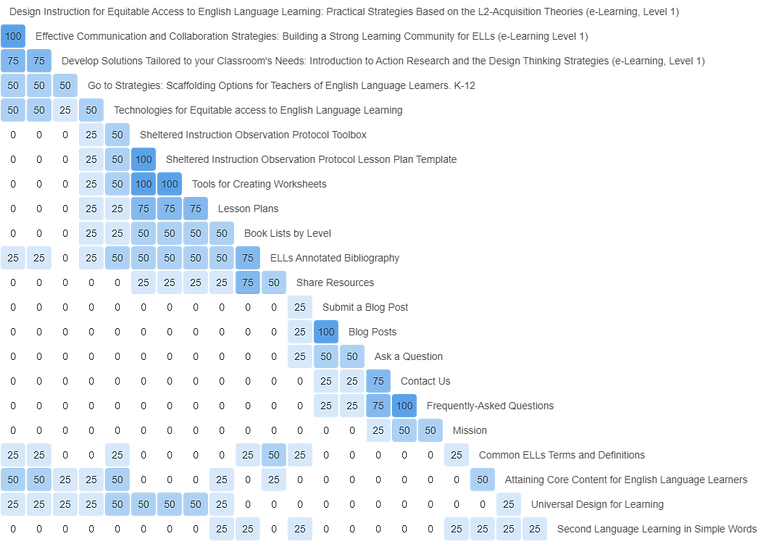This project aimed to create an online learning community for teachers and parents at a local school who needed instructional strategies and resources for supporting English language learners (ELLs) to address the academic achievement gap that separated ELLs and other students. The platform provides foundational knowledge on second-language acquisition theories, practical teaching strategies, and teaching and learning resources. I identified the needs of teachers and parents in supporting ELLs through foundational research. With active stakeholder participation, I designed a prototype. This project represents the culmination of my learning in applying the Design Thinking model to develop instructional products and website design.
THE PROBLEM
Teachers and parents at a school in my community have expressed concerns that their ELLs' language needs are not being met, leading to low test scores in English Language Arts (ELA), in some cases falling below grade level. Both teachers and parents have been seeking additional support.
EMPATHIZE
NA PROPOSAL & PLAN
To investigate the problem and identify the students', parents', and teachers' needs, feelings, and thoughts. Following the Design Thinking model, I surveyed and interviewed some teachers and parents, and conducted in-class observations. Then, I created empathy maps and identified three personas that summarize the users' pain points and goals. Then, I created the journey maps to identify opportunities for improvement in the parents' and teachers' experiences.

EMPATHY MAPS, PERSONAS, & JOURNEY MAPS
The following are the goal statements in alignment with the identified needs that I prioritized based on their magnitude, feasibility, and risks if they were not met.
-
Teachers in upper grades will be able to develop learning materials that are appropriate for the grade level, age, and personal interests of the ELLs by August 2021.
-
Parents of ELLs will be able to develop a basic understanding of ELD based on L2 acquisition theories by September 2021 and apply simple language learning strategies at home by January 2022.
-
Teachers in upper grades will improve their ELD instructional strategies by 64% (target performance at the adequacy level) by the beginning of 2022 and by 84% (target performance at the excellence level) by the end of the school year 2022.
-
Teachers in lower grades will continue to learn innovative strategies to provide quality instruction to ELLs by 2023.
CAUSAL ANALYSIS
Using the fishbone technique, I identified several root causes of the problem, including teachers' performance gaps due to limited resources and the ineffectiveness of past training initiatives, parents' limited knowledge of second language development, and students' diverse characteristics, such as learner variability and different language needs.
Limitations: Greater teacher participation and permission for extensive in-class observations would have provided deeper insights into the areas of need, allowing for more reliable generalization of the findings to the broader school population.
DEFINE
NEEDS ASSESSMENT REPORT & ACTION PLAN
It was clear that both teachers and parents needed targeted learning experiences to enhance their knowledge of second-language acquisition, as well as access to resources for ELLs. An online learning community offering educational experiences and enrichment resources emerged as a suitable solution. Additional strategies and alternative solutions to address performance and knowledge gaps were outlined in the needs assessment report and action plan.

IDEATE
HOW-MIGHT-WE STATEMENTS
.jpg)
COMPETITIVE AUDIT
A learning community with practical learning solutions and aids for second language development at school and beyond would fit the instructors' and parents' diverse needs. However, before identifying the details of the solution, I evaluated the solutions provided by three direct and two indirect competitors.
I identified several gaps that, if addressed, could better support the target population:
-
A virtual environment for practicing language development strategies, facilitating the transfer of skills to real classroom settings.
-
Separate portals for educators and parents to cater to their distinct needs effectively.
-
A variety of learning experience formats to accommodate diverse learning preferences and styles.

CARD SORTING, TREE TESTING, & SITEMAP
With the users' needs in mind, I run an open card-sorting test to organize the website content and a tree study to test the preliminary organization. After looking at the patterns of cards put together by the participants frequently and the tree testing results, I came up with the sitemap from the teachers' and parents' views illustrated above.
PAPER WIREFRAMES
Additionally, I experimented with the website layout, by creating different versions of the most important pages for desktop and mobile devices and discussed the preliminary designs with others.
PROTOTYPE & TEST
LOW-FI PROTOTYPE & USABILITY TESTS (TEACHERS' WEBSITE)


After I identified the preliminary designs for the website for teachers, I developed the low-fidelity prototype in Adobe XD and conducted a usability test with five participants (see the usability test plan). This process helped me develop the following insights:
-
Based on the theme that the page title "Archives" is not indicative of the page's content, an insight is that there is a need for a clearer page title.
-
Based on the theme that the users need a more intuitive way to leave feedback about the training courses on the website, an insight is that a comment section on the training courses' description pages would be a more intuitive feature.
-
Based on the theme that the Information Architecture is not effective so that the users can leverage all the learning opportunities available on the website, an insight was that the pages under the Resources and Communicate folders must be organized better.
Lastly, I created the high-fidelity mockups and prototype of the website. In the images below, you can see the improvements as informed by the research data analysis.
MOCKUPS & HIGH-FI PROTOTYPE (TEACHERS' WEBSITE)
Before

After

Before
After



.jpg)
.jpg)
